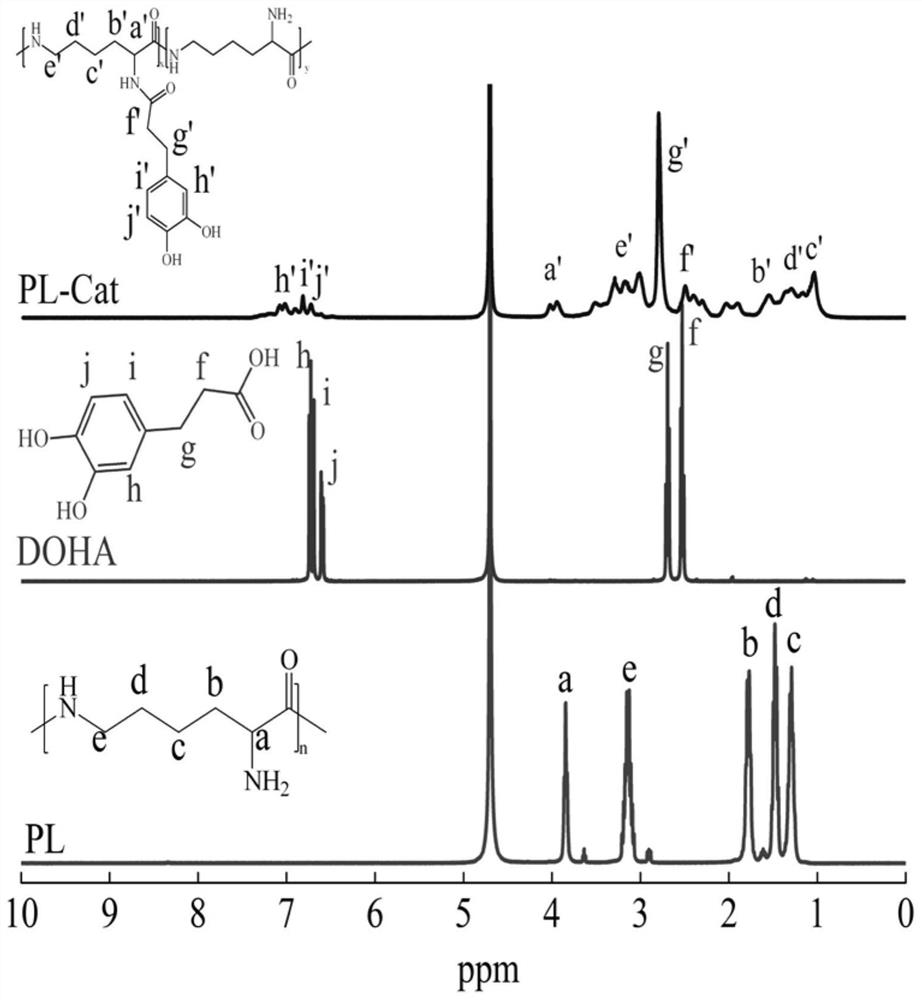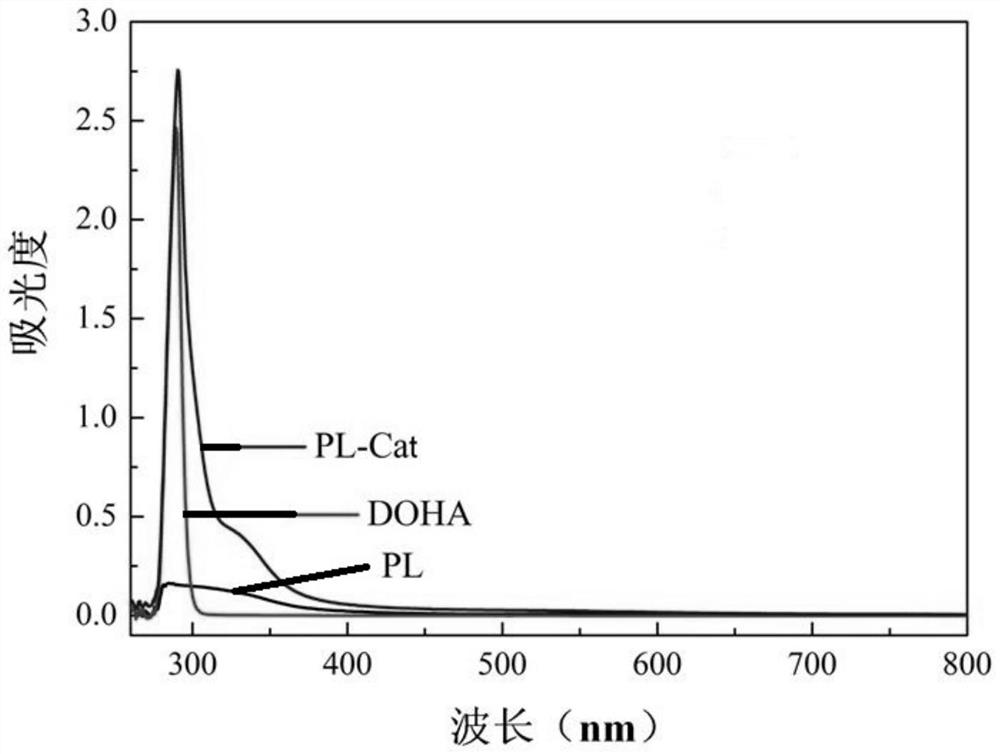Mussel-like coordination adhesive based on epsilon-polylysine and preparation method of mussel-like coordination adhesive
A technology of polylysine and adhesives, applied in surgical adhesives, medical science, surgery, etc., can solve the problems of low immune response, poor safety, easy to cause inflammation, etc., and achieve low cytotoxicity and high adhesive strength Effect
- Summary
- Abstract
- Description
- Claims
- Application Information
AI Technical Summary
Problems solved by technology
Method used
Image
Examples
Embodiment 1
[0034] Synthesis of catechol-modified polylysine (PL-Cat): under nitrogen, 1.5g ε-polylysine (PL) was dissolved in 50mL distilled water, 1.28g 3,4 dihydroxyphenylpropane acid (DOHA) was dissolved in 30 mL of distilled water, and the two were mixed evenly, and then 6.74 g of 1-(3-dimethylaminopropyl)-3-ethylcarbodiimide hydrochloride (EDC·HCl ) and 809mg of N-hydroxysuccinimide (NHS) mixed aqueous solution 30mL, adding 2M hydrochloric acid (HCl) to adjust the pH of the solution to 5.5, mixed reaction for 24h, the product was first treated with PBS (pH5.5 ) dialyzed for 48 hours, then dialyzed against distilled water for 10 hours, and finally freeze-dried for 48 hours to obtain catechol-modified ε-polylysine (PL-Cat), the main component of the adhesive.
[0035] Preparation of mussel-like coordination binder based on ε-polylysine (PL): Dissolve 50 mg PL-Cat in 82.8 μL distilled water, add 22.2 μL FeCl to it 3 Aqueous solution (128mg / mL), vortex to mix evenly, add 5M NaOH to it ...
Embodiment 2
[0037] Synthesis of catechol-modified polylysine (PL-Cat): under nitrogen, 3gε-polylysine (PL) was dissolved in 100mL distilled water, 2.56g 3,4 dihydroxyphenylpropionic acid (DOHA) was dissolved in 60 mL of distilled water, and the two were mixed evenly, and then 13.48 g of 1-(3-dimethylaminopropyl)-3-ethylcarbodiimide hydrochloride (EDC·HCl) was added thereto and 60mL of mixed aqueous solution of 1.618g N-hydroxysuccinimide (NHS), add 5M hydrochloric acid (HCl) to adjust the pH of the solution to 5.5, mix and react for 24h, and the product is first treated with PBS (pH5.5 ) dialyzed for 48 hours, then dialyzed against distilled water for 10 hours, and finally freeze-dried for 48 hours to obtain catechol-modified ε-polylysine (PL-Cat), the main component of the adhesive.
[0038] Preparation of mussel-like coordination binder based on ε-polylysine (PL): Dissolve 100 mg PL-Cat in 152.7 μL distilled water, add 53.2 μL FeCl 3 Aqueous solution (128mg / mL), vortex to mix evenly, a...
Embodiment 3
[0040] Synthesis of catechol-modified polylysine (PL-Cat): under argon atmosphere, 3gε-polylysine (PL) was dissolved in 100mL distilled water, and 5.12g 3,4 dihydroxyphenylpropane Acid (DOHA) was dissolved in 120mL of distilled water, and the two were mixed evenly, then 26.96g of 1-(3-dimethylaminopropyl)-3-ethylcarbodiimide hydrochloride (EDC·HCl ) and 3.236g of N-hydroxysuccinimide (NHS) mixed aqueous solution 120mL, adding 5M hydrochloric acid (HCl) to adjust the pH of the solution to 5.5, mixed for 24h, the product was first treated with PBS (pH5. 5) Dialyze for 48 hours, then dialyze against distilled water for 10 hours, and finally freeze-dry for 48 hours to obtain catechol-modified ε-polylysine (PL-Cat), the main component of the adhesive.
[0041]Preparation of mussel-like coordination binder based on ε-polylysine (PL): 100 mg PL-Cat was dissolved in 137.4 μL distilled water, and 66.6 μL FeCl was added to it 3 Aqueous solution (128mg / mL), vortex to mix evenly, add 4M ...
PUM
| Property | Measurement | Unit |
|---|---|---|
| Adhesive strength | aaaaa | aaaaa |
| Number average molecular weight | aaaaa | aaaaa |
Abstract
Description
Claims
Application Information
 Login to View More
Login to View More - R&D
- Intellectual Property
- Life Sciences
- Materials
- Tech Scout
- Unparalleled Data Quality
- Higher Quality Content
- 60% Fewer Hallucinations
Browse by: Latest US Patents, China's latest patents, Technical Efficacy Thesaurus, Application Domain, Technology Topic, Popular Technical Reports.
© 2025 PatSnap. All rights reserved.Legal|Privacy policy|Modern Slavery Act Transparency Statement|Sitemap|About US| Contact US: help@patsnap.com



